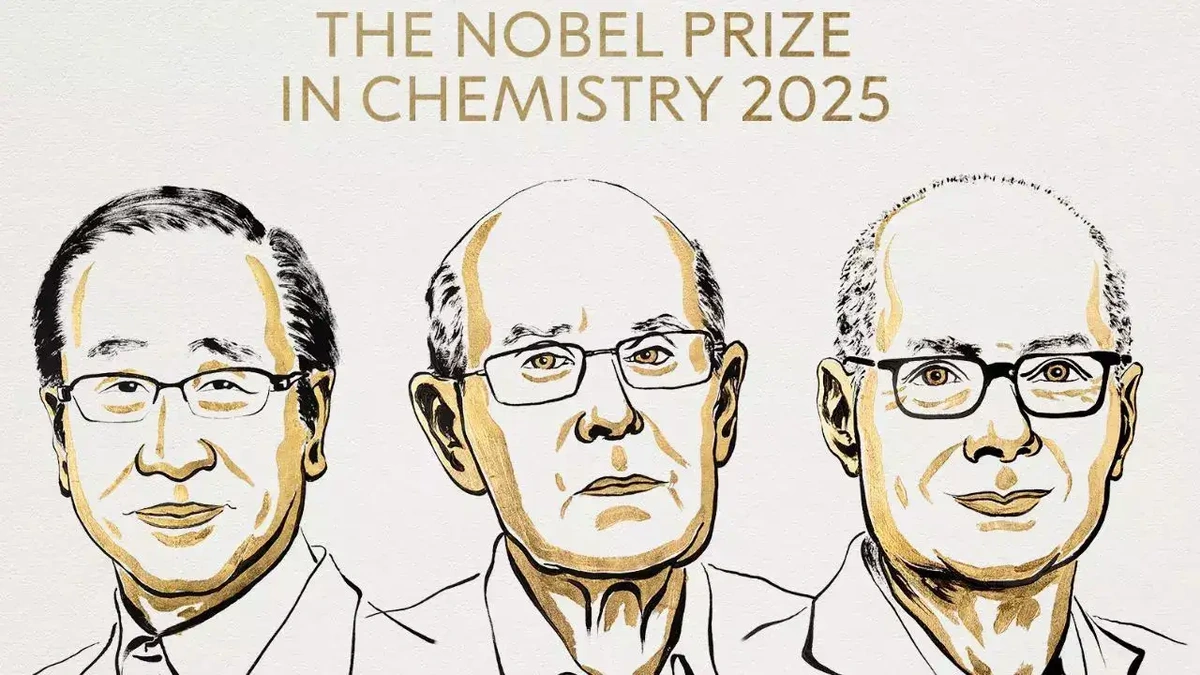Okay, folks, let’s be real. The Nobel Prize is a big deal. It’s not just some pat on the back; it’s a recognition of groundbreaking work that reshapes our understanding of the world. So, when the names Susumu Kitagawa, Richard Robson, and Omar M. Yaghi started buzzing in connection with the 2025 Nobel Prize in Chemistry , the science world sat up and took notice. But here’s the thing – why them ? What did they do that was so revolutionary? I mean, let’s dive deeper because this is about more than just flashy lab coats and bubbling beakers.
We’re not just talking about incremental improvements here. We’re talking about a paradigm shift – the creation and development of Metal-Organic Frameworks (MOFs) . It sounds intimidating, I know, but trust me, the implications are mind-blowing. That’s where these three maestros come in.
The “Why” Behind the Acclaim | MOFs Explained

So, what exactly are Metal-Organic Frameworks? Imagine tiny, perfectly designed cages at the molecular level. Think of them like incredibly porous sponges, but instead of soaking up water, they trap gases, store energy, and even catalyze chemical reactions. What fascinates me is the level of control scientists now have over matter at an atomic scale. These aren’t just random structures; they’re meticulously engineered to perform specific tasks. Learn about more uses of MOFs .
But why is this so important? Well, think about some of the biggest challenges facing humanity: climate change, energy storage, and clean water. MOFs offer potential solutions to all of them. They can capture carbon dioxide from the atmosphere, store hydrogen for fuel cells, and filter pollutants from water. It’s like having a microscopic Swiss Army knife for solving global problems. The potential applications of MOFs are almost limitless.
And that’s the core of it. The Nobel committee isn’t just rewarding clever chemistry; they’re recognizing a technology with the power to transform our future. Initially, I thought this was just about scientific achievement, but then I realized it’s about the profound impact on society.
The Pioneers | Kitagawa, Robson, and Yaghi
Let’s give credit where it’s due. Susumu Kitagawa, Richard Robson, and Omar M. Yaghi are the intellectual powerhouses behind the MOF revolution. Each brought unique expertise and vision to the table.
Kitagawa’s work focused on creating the first examples of porous coordination polymers, laying the groundwork for MOFs. Robson’s contributions involved the design and synthesis of complex, interpenetrating frameworks. And Yaghi is credited with coining the term “Metal-Organic Frameworks” and developing reticular chemistry – the art of building structures from molecular building blocks.
What’s truly remarkable is how these seemingly disparate approaches converged to create a new field of chemistry. It’s a testament to the power of collaboration and the cross-pollination of ideas. This collaborative spirit highlights the significance of scientific research and knowledge sharing.
MOFs | More Than Just Lab Curiosities
Okay, so we know MOFs are cool, but how are they actually being used in the real world? That’s where things get really exciting. Several companies are already using MOFs to improve gas storage in vehicles, making them more efficient and reducing emissions. Others are exploring their use in water purification, removing harmful contaminants from drinking water.
What fascinates me is how adaptable these materials are. Scientists are constantly tweaking their design to optimize them for specific applications. It’s like having a programmable material that can be tailored to solve a wide range of problems. The real-world applications are rapidly expanding and it’s something to keep an eye on.
But, and this is a big but, there are still challenges to overcome. Scaling up production of MOFs is expensive, and their long-term stability needs to be improved. However, the potential benefits are so enormous that researchers are working tirelessly to address these issues.
The Future is Porous | MOFs and Beyond
So, what does the future hold for MOFs? I see a world where these materials are ubiquitous – used in everything from air filters to batteries to drug delivery systems. Imagine buildings that can capture carbon dioxide directly from the air or medicines that are released precisely where they’re needed in the body.
But beyond the specific applications, I think MOFs represent a fundamental shift in how we think about materials. We’re moving away from passive materials to active ones – materials that can respond to their environment and perform specific tasks. This is the dawn of a new era of materials science, and MOFs are leading the way. This paradigm shift signifies a revolution in material science .
And that, my friends, is why Susumu Kitagawa, Richard Robson, and Omar M. Yaghi deserve the 2025 Nobel Prize in Chemistry. They didn’t just discover something new; they created a whole new world of possibilities. The climate crisis is another area where MOFs can be helpful.
FAQ about the Nobel Prize and Metal-Organic Frameworks
What exactly are the limitations of MOFs?
While MOFs hold immense promise, limitations include high production costs and ensuring long-term stability for widespread applications.
How do MOFs contribute to environmental sustainability?
MOFs can capture carbon dioxide from the atmosphere and filter pollutants from water, offering practical solutions for sustainability.
Are there any commercial applications of MOFs currently available in the market?
Yes, MOFs are used to enhance gas storage in vehicles, boosting efficiency and lowering emissions, and are employed in water purification processes.
Can MOFs really help in drug delivery within the human body?
Yes, scientists are exploring MOFs for targeted drug delivery, which can improve how medicines are administered and absorbed in the body.
Why are MOFs considered so innovative in the field of chemistry?
MOFs represent a paradigm shift because they provide tailored control over matter at an atomic scale, leading to materials that can perform specific tasks.
When will the Nobel laureates receive their awards?
The Nobel laureates will receive their awards at the official Nobel Prize ceremony in December 2025.




